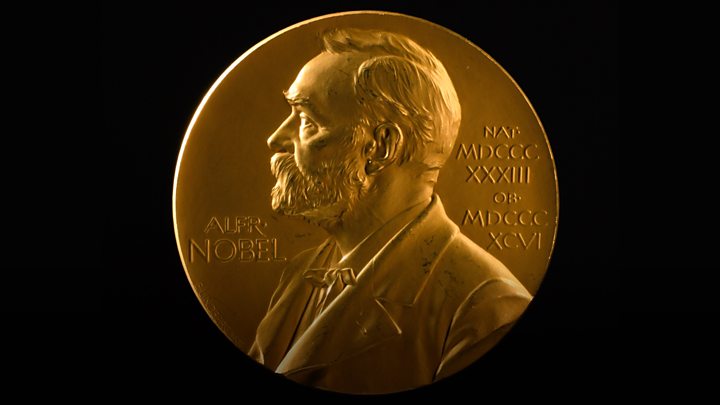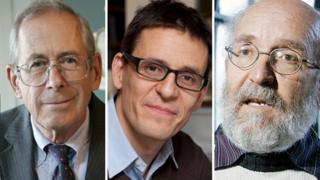James Peebles (L), Didier Queloz (C) and Michel Mayor (R) share the nine million kronor prize
Three scientists have been awarded the 2019 Nobel Prize in Physics for “ground-breaking” discoveries about the Universe.
James Peebles, Michel Mayor and Didier Queloz were announced as this year’s winners at a ceremony in Stockholm.
They were jointly awarded the prize for work on the evolution of the Universe and the discovery of a distant planet around a Sun-like star in 1995.
The winners will share the prize money of nine million kronor (£738,000).
Ulf Danielsson, a member of the Nobel Committee, commented: “Both these prizes… tell us something essential, something existential about our place in the Universe.”
“The first one, tracing the history back to an unknown origin, is so fascinating. The other one tries to answer these questions about: ‘are we alone – is there life anywhere else in the Universe?'”

Media playback is unsupported on your device
Winnipeg, Canada-born James Peebles was honoured for his contributions to the understanding of the evolution of the Universe and Earth’s place in the cosmos.
With others, he predicted the existence of cosmic microwave background radiation, the so-called afterglow of the Big Bang.
“Cosmic background radiation was discovered in 1965, and turned out to be a goldmine for our understanding of how the Universe developed from its early childhood to the present day,” said Mats Larsson, chair of the Nobel physics prize committee.
“Were it not for the theoretical discoveries of James Peebles, the wonderful high-precision measurements of this radiation over the last 20 years would have told us almost nothing.”
The 84-year-old cosmologist, who is now based at Princeton University in New Jersey, US, also made major contributions to the theory of dark matter and dark energy, the mysterious components which together make up some 95% of the Universe.
He also helped develop the theoretical framework of structure formation – which describes how galaxies and other large structures emerged from earlier density fluctuations in the Universe.
Asked what he considered his most important contribution, Prof Peebles said he was “hard-pressed to say”, adding that his work had been collaborative.
Image copyright
ESO / M Kornmesser
Artwork: Michel Mayor and Didier Queloz have won for their detection of the distant planet 51 Pegasi b
“It’s a life’s work,” he told the news conference at the Royal Swedish Academy of Sciences in Stockholm.
Michel Mayor and Didier Queloz were awarded the prize for finding 51 Pegasi b, a gas giant orbiting a star 50 light-years away.
It was the first exoplanet discovered around a main-sequence star – ones that fuse hydrogen atoms to form helium atoms in their cores. These are the most numerous kind of star in the Universe, and include our own Sun.
They used the pioneering radial velocity technique. This detects distant worlds indirectly, by measuring how a parent star “wobbles” when it is tugged on by the gravity of an orbiting planet.
The stronomers were working at the University of Geneva, Switzerland, when the discovery was made. Mayor, 77, is still there as a professor emeritus; Queloz, 53, now holds positions at Geneva and at the University of Cambridge, UK.
Michael Moloney, chief executive officer of the American Institute of Physics, said: “Their groundbreaking work on discovering the fundamental nature of the Universe and new worlds in distant solar systems has opened up whole new areas of research in cosmology and exoplanet science.
“The discovery of a planet orbiting a star outside our own system has changed our perceptions of our place in the Universe – a Universe that still holds many mysteries to solve.”
Follow Paul on Twitter.
Previous winners of the Nobel Prize in Physics
Image copyright
S.Ossokine/A.Buonanno (MPI Gravitational Physics)
A computer simulation of gravitational waves radiating from two merging black holes
2018 – Donna Strickland, Arthur Ashkin and Gerard Mourou were awarded the prize for their discoveries in the field of laser physics.
2017 – Rainer Weiss, Kip Thorne and Barry Barish earned the award for the detection of gravitational waves.
2016 – David Thouless, Duncan Haldane and Michael Kosterlitz shared the award for their work on rare phases of matter.
2015 – Takaaki Kajita and Arthur McDonald were awarded the prize the discovery that neutrinos switch between different “flavours”.
2014 – Isamu Akasaki, Hiroshi Amano and Shuji Nakamura won the physics Nobel for developing the first blue light-emitting diodes (LEDs).
2013 – Francois Englert and Peter Higgs shared the spoils for formulating the theory of the Higgs boson particle.
2012 – Serge Haroche and David J Wineland were awarded the prize for their work with light and matter.



-225x125.jpg)












